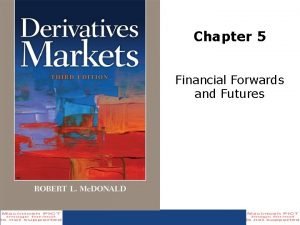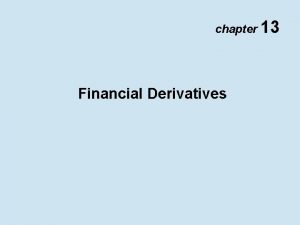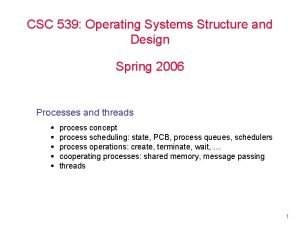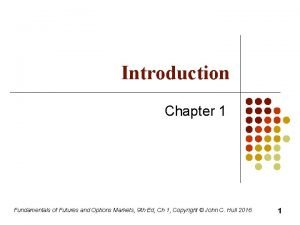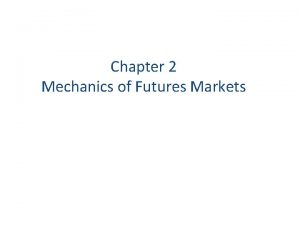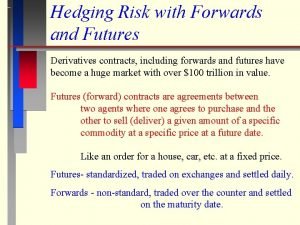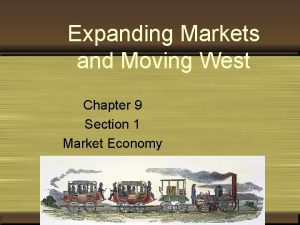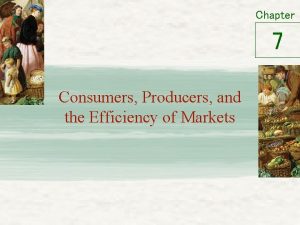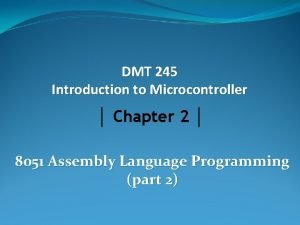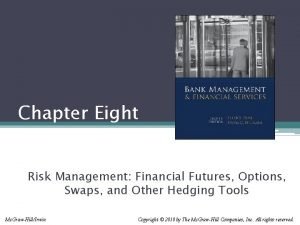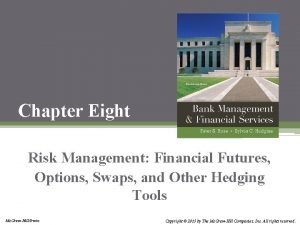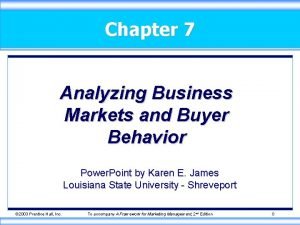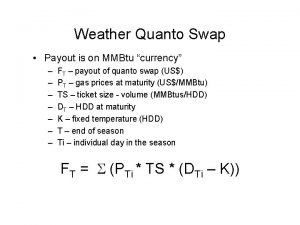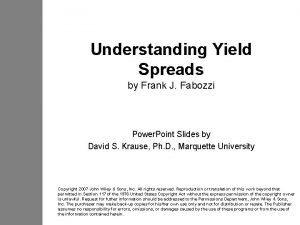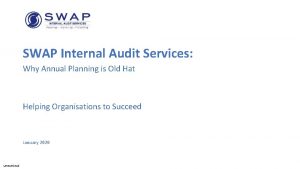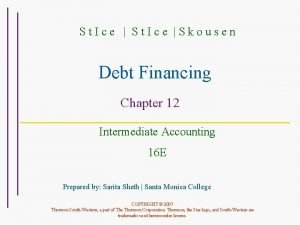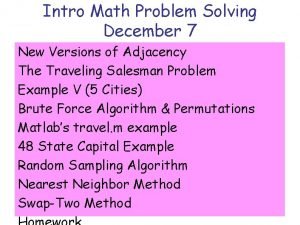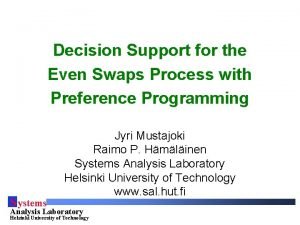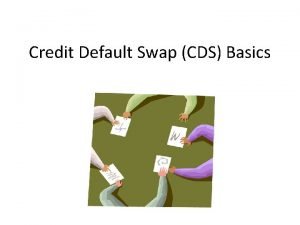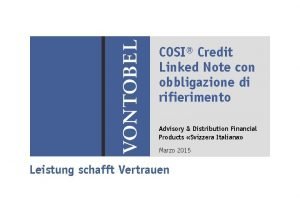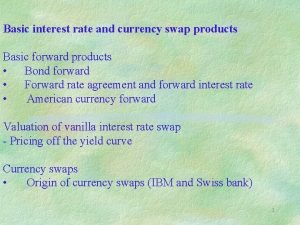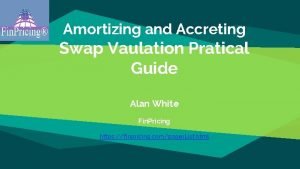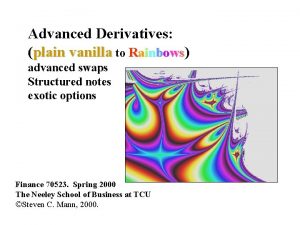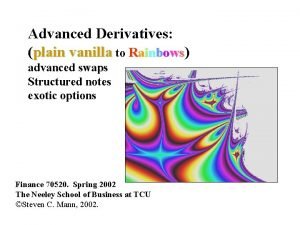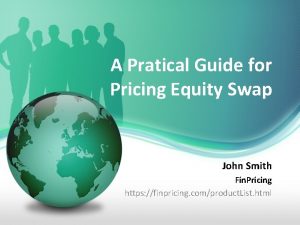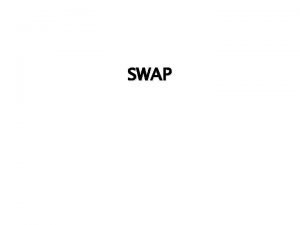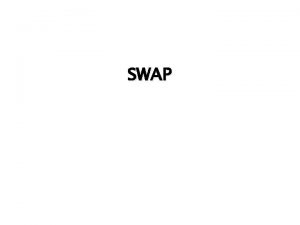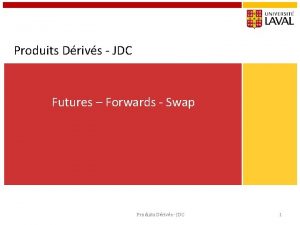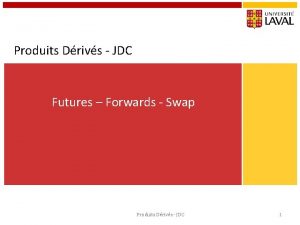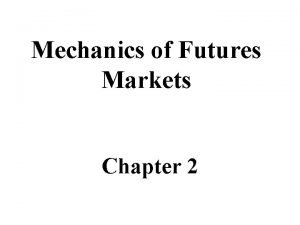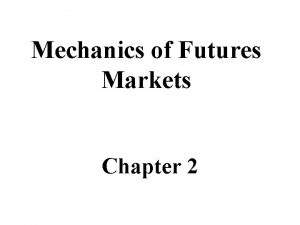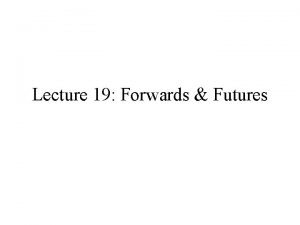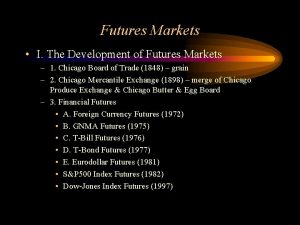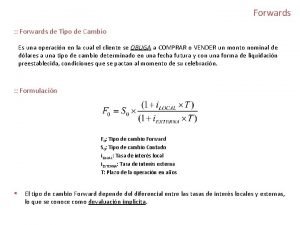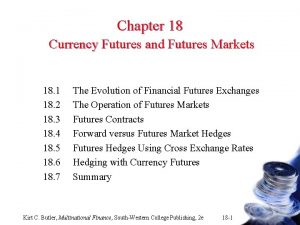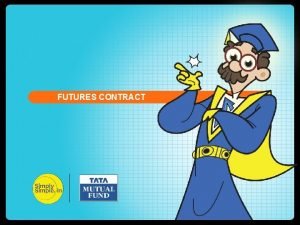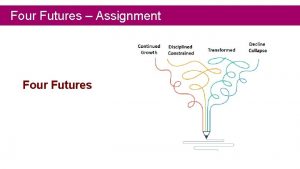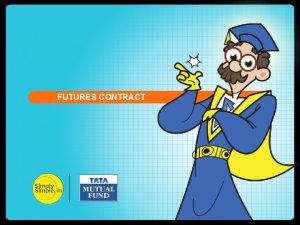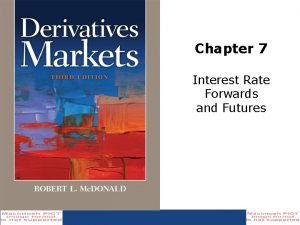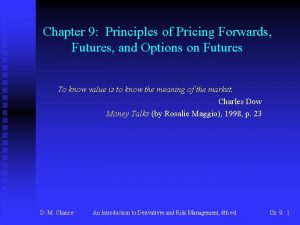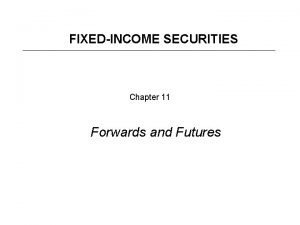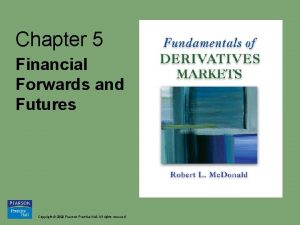Chapter 20 Futures Forwards and Swap Markets 2015






















































- Slides: 54

Chapter 20 Futures, Forwards, and Swap Markets © 2015 Mc. Graw-Hill Ryerson Limited

Chapter Summary • Objective: To describe the workings of futures markets and the mechanics of trading in these markets. • • Trading mechanics Futures pricing Different types of futures contracts Swaps © 2015 Mc. Graw-Hill Ryerson Limited 20 -2

Futures and Forwards • • • Forward - an agreement calling for a future delivery of an asset at an agreed-upon price Futures - similar to forward but feature formalized and standardized characteristics Key difference in futures • • Secondary trading - liquidity Marked to market Standardized contract units Clearinghouse warrants performance © 2015 Mc. Graw-Hill Ryerson Limited 20 -3

Key Terms for Futures Contracts • • Futures price - agreed-upon price at maturity Long position - agree to purchase Short position - agree to sell Profits on positions at maturity Long = spot minus original futures price Short = original futures price minus spot © 2015 Mc. Graw-Hill Ryerson Limited 20 -4

Figure 20. 1 Prices for Canadian Commodity Futures, June 6, 2013 © 2015 Mc. Graw-Hill Ryerson Limited 20 -5

Figure 20. 2 Profits to Buyers and Sellers of Futures and Option Contracts © 2015 Mc. Graw-Hill Ryerson Limited 20 -6

Types of Contracts • • Agricultural commodities Metals and minerals (including energy contracts) Foreign currencies Financial futures Interest rate futures Stock index futures © 2015 Mc. Graw-Hill Ryerson Limited 20 -7

Table 20. 1 Sample of Future Contracts © 2015 Mc. Graw-Hill Ryerson Limited 20 -8

Summary Reminder • Objective: To describe the workings of futures markets and the mechanics of trading in these markets. • • Trading mechanics Futures pricing Different types of futures contracts Swaps © 2015 Mc. Graw-Hill Ryerson Limited 20 -9

Trading Mechanics • Clearinghouse - acts as a party to all buyers and sellers. • • Obligated to deliver or supply delivery Closing out positions • • • Reversing the trade Take or make delivery Most trades are reversed and do not involve actual delivery © 2015 Mc. Graw-Hill Ryerson Limited 20 -10

Figure 20. 3 Panel A: Trading without a Clearinghouse, Panel B: Trading with a Clearinghouse © 2015 Mc. Graw-Hill Ryerson Limited 20 -11

Margin and Trading Arrangements • • • Initial Margin - funds deposited to provide capital to absorb losses Marking to Market - each day the profits or losses from the new futures price are reflected in the account. Maintenance or variation margin - an established value below which a trader’s margin may not fall. © 2015 Mc. Graw-Hill Ryerson Limited 20 -12

Margin and Trading Arrangements • • Margin call - when the maintenance margin is reached, broker will ask for additional margin funds Convergence of Price - as maturity approaches the spot and futures price converge Delivery - Actual commodity of a certain grade with a delivery location or for some contracts cash settlement Cash Settlement – some contracts are settled in cash rather than delivery of the underlying assets © 2015 Mc. Graw-Hill Ryerson Limited 20 -13

Trading Strategies • Speculation • • • short - believe price will fall long - believe price will rise Hedging • • long hedge - protecting against a rise in price short hedge - protecting against a fall in price © 2015 Mc. Graw-Hill Ryerson Limited 20 -14

Basis and Basis Risk • Basis - the difference between the futures price and the spot price • • over time the basis will likely change and will eventually converge Basis Risk - the variability in the basis that will affect profits and/or hedging performance © 2015 Mc. Graw-Hill Ryerson Limited 20 -15

Summary Reminder • Objective: To describe the workings of futures markets and the mechanics of trading in these markets. ü Trading mechanics • • • Futures pricing Different types of futures contracts Swaps © 2015 Mc. Graw-Hill Ryerson Limited 20 -16

Futures Pricing • • Spot-futures parity theorem - two ways to acquire an asset for some date in the future Purchase it now and store it Take a long position in futures These two strategies must have the same market determined costs © 2015 Mc. Graw-Hill Ryerson Limited 20 -17

Spot-Futures Parity Theorem • • • With a perfect hedge the futures payoff is certain - there is no risk A perfect hedge should return the riskless rate of return This relationship can be used to develop futures pricing relationship © 2015 Mc. Graw-Hill Ryerson Limited 20 -18

Hedge: Text Example • • Investor owns an S&P/TSX 60 fund that has a current value equal to the index of $800 Assume dividends of $10 will be paid on the index at the end of the year Assume futures contract that calls for delivery in one year is available for $816 Assume the investor hedges by selling or shorting one contract © 2015 Mc. Graw-Hill Ryerson Limited 20 -19

Hedge Example - Outcomes Value of ST 760 810 840 ($816 - ST) 56 6 -24 Dividend Income 10 10 10 Payoff on Short Total © 2015 Mc. Graw-Hill Ryerson Limited 826 826 20 -20

Rate of Return for the Hedge © 2015 Mc. Graw-Hill Ryerson Limited 20 -21

General Spot-Futures Parity Rearranging terms: © 2015 Mc. Graw-Hill Ryerson Limited 20 -22

Figure 20. 4 S&P 500 Monthly Dividend Yield © 2015 Mc. Graw-Hill Ryerson Limited 20 -23

Arbitrage Possibilities • • • If spot-futures parity is not observed, then arbitrage is possible If the futures price is too high, short the futures and acquire the stock by borrowing the money at the risk-free rate If the futures price is too low, go long futures, short the stock and invest the proceeds at the risk-free rate © 2015 Mc. Graw-Hill Ryerson Limited 20 -24

Spread Pricing: Parity for Spreads © 2015 Mc. Graw-Hill Ryerson Limited 20 -25

Figure 20. 5 Gold Futures Prices © 2015 Mc. Graw-Hill Ryerson Limited 20 -26

Summary Reminder • Objective: To describe the workings of futures markets and the mechanics of trading in these markets. ü Trading mechanics ü Futures pricing • • Different types of futures contracts Swaps © 2015 Mc. Graw-Hill Ryerson Limited 20 -27

Commodity Futures Pricing General principles that apply to stock apply to commodities Carrying costs are more for commodities Spoilage is a concern Where; © 2015 Mc. Graw-Hill Ryerson Limited F 0 = futures price P 0 = cash price of the asset C = Carrying cost c = C/P 0 20 -28

Figure 20. 6 Typical Commodity Price Pattern over the Season © 2015 Mc. Graw-Hill Ryerson Limited 20 -29

Discounted Cash Flow Analysis • • • The modern approach to commodity futures prices as estimates of future commodity prices uses portfolio theory Current prices are expected future prices discounted at a risk adjusted discount rate This rate is estimated from commodity betas © 2015 Mc. Graw-Hill Ryerson Limited 20 -30

Table 20. 2 Commodity Betas © 2015 Mc. Graw-Hill Ryerson Limited 20 -31

Futures Price versus Expected Spot Price: Theories • • • © 2015 Mc. Graw-Hill Ryerson Limited Expectations Normal Backwardation Contango 20 -32

Figure 20. 7 Futures Price Over Time in the Special Case that the Expected Spot Price Remains Unchanged © 2015 Mc. Graw-Hill Ryerson Limited 20 -33

Stock Index Contracts • • Available on both domestic and international stocks Advantages over direct stock purchase • • • lower transaction costs better for timing or allocation strategies takes less time to acquire the portfolio © 2015 Mc. Graw-Hill Ryerson Limited 20 -34

Table 20. 3 Major Stock-Index Futures © 2015 Mc. Graw-Hill Ryerson Limited 20 -35

Table 20. 4 Correlations among Major U. S. Stock Market Indexes © 2015 Mc. Graw-Hill Ryerson Limited 20 -36

Using Stock Index Contracts to Create Synthetic Positions • Synthetic stock purchase • • Purchase of the stock index instead of actual shares of stock Creation of a synthetic T-bill plus index futures that duplicates the payoff of the stock index contract © 2015 Mc. Graw-Hill Ryerson Limited 20 -37

Pricing on Stock Index Contracts • The spot-futures price parity is given as: • Empirical investigations have shown that the actual pricing relationship on index contracts follows the spot-futures relationship © 2015 Mc. Graw-Hill Ryerson Limited 20 -38

Index Arbitrage • • • Exploiting mispricing between underlying stocks and the futures index contract Futures Price too high - short the future and buy the underlying stocks Futures price too low - long the future and short sell the underlying stocks © 2015 Mc. Graw-Hill Ryerson Limited 20 -39

Index Arbitrage and Program Trading • Difficult to implement in practice • • • Transactions costs are often too large Trades cannot be done simultaneously Development of Program Trading • • Used by arbitrageurs to perform index arbitrage Permits acquisition of securities quickly © 2015 Mc. Graw-Hill Ryerson Limited 20 -40

Foreign Exchange Futures • Futures markets • • Chicago Mercantile (International Monetary Market) London International Financial Futures Exchange Active forward market Differences between futures and forward markets © 2015 Mc. Graw-Hill Ryerson Limited 20 -41

Figure 20. 8 A: Foreign Exchange Listing, Cross Rates, July 19, 2013 © 2015 Mc. Graw-Hill Ryerson Limited 20 -42

Figure 20. 8 B: Canadian Dollar Forward Rates, July 19, 2013 © 2015 Mc. Graw-Hill Ryerson Limited 20 -43

Figure 20. 9 Canadian Dollar Futures in the CME, July 20, 2013 © 2015 Mc. Graw-Hill Ryerson Limited 20 -44

Pricing on Foreign Exchange Futures • • Interest rate parity theorem Developed using the Canadian Dollar and British Pound where, F 0 is the forward price E 0 is the current exchange rate © 2015 Mc. Graw-Hill Ryerson Limited 20 -45

Text Pricing Example r. CAN = 6% ruk = 5% E 0 = $1. 60 per pound • T = 1 yr If the futures price varies from $2. 12 per pound arbitrage opportunities will be present © 2015 Mc. Graw-Hill Ryerson Limited 20 -46

Interest Rate Futures • Domestic interest rate contracts • • • International contracts • • Bankers’ Acceptances (BAX) Canada bonds Eurodollar Hedging • • Underwriters Firms issuing debt © 2015 Mc. Graw-Hill Ryerson Limited 20 -47

Hedging Interest Rate Risk • • Owners of fixed-income portfolios protecting against a rise in rates Corporations planning to issue debt securities protecting against a rise in rates Investor hedging against a decline in rates for a planned future investment Exposure for a fixed-income portfolio is proportional to modified duration © 2015 Mc. Graw-Hill Ryerson Limited 20 -48

Summary Reminder • Objective: To describe the workings of futures markets and the mechanics of trading in these markets. ü Trading mechanics ü Futures pricing ü Different types of futures contracts • © 2015 Mc. Graw-Hill Ryerson Limited Swaps 20 -49

Swaps • • • © 2015 Mc. Graw-Hill Ryerson Limited Interest rate swap Foreign exchange swap Credit risk on swaps 20 -50

Figure 20. 10 Interest Rate Swap © 2015 Mc. Graw-Hill Ryerson Limited 20 -51

Figure 20. 11 Interest Rate Futures © 2015 Mc. Graw-Hill Ryerson Limited 20 -52

Pricing on Swap Contracts • • • Swaps are essentially a series of forward contracts One difference is that the swap is usually structured with the same payment each period while the forward rate would be different each period Using a foreign exchange swap as an example, the swap pricing would be described by the following formula © 2015 Mc. Graw-Hill Ryerson Limited 20 -53

Figure 20. 12 Forward Contracts versus Swaps Panel A: Two forward contracts, each priced independently Panel B: Two-year swap agreement © 2015 Mc. Graw-Hill Ryerson Limited 20 -54
 Synthetic forward contract
Synthetic forward contract Advantages and disadvantages of derivatives
Advantages and disadvantages of derivatives Memory management unit
Memory management unit Swap out swap in
Swap out swap in Swap out swap in
Swap out swap in Forward vs option
Forward vs option Mechanics of futures markets
Mechanics of futures markets Mechanics of futures market
Mechanics of futures market Mechanics of futures markets
Mechanics of futures markets Fx forwards manchester
Fx forwards manchester Hedging with forward contracts
Hedging with forward contracts Forward valuation
Forward valuation Mercados de forwards y swaps
Mercados de forwards y swaps When i was one i had just begun the day i went to sea
When i was one i had just begun the day i went to sea Tailing the hedge
Tailing the hedge Why study financial markets and institutions chapter 1
Why study financial markets and institutions chapter 1 Characteristics of consumer behaviour
Characteristics of consumer behaviour Chapter 9 expanding markets and moving west
Chapter 9 expanding markets and moving west Business markets and buying behaviour
Business markets and buying behaviour Business buyer behavior refers to the
Business buyer behavior refers to the Chapter 5 consumer markets and buyer behavior
Chapter 5 consumer markets and buyer behavior Chapter 9 expanding markets and moving west
Chapter 9 expanding markets and moving west Chapter 9 expanding markets and moving west
Chapter 9 expanding markets and moving west Chapter 7 consumers producers and the efficiency of markets
Chapter 7 consumers producers and the efficiency of markets Flag register of 8051 microcontroller
Flag register of 8051 microcontroller Options futures and risk management
Options futures and risk management Options futures and other derivatives
Options futures and other derivatives Options futures and risk management
Options futures and risk management Currency futures
Currency futures Hedging strategies using futures and options
Hedging strategies using futures and options Cultural dynamics in assessing global markets
Cultural dynamics in assessing global markets Analyzing business markets chapter 7 ppt
Analyzing business markets chapter 7 ppt Chapter 18 the markets for the factors of production
Chapter 18 the markets for the factors of production Analyzing consumer markets
Analyzing consumer markets Firms in competitive markets chapter 14 ppt
Firms in competitive markets chapter 14 ppt Quanto swap pricing
Quanto swap pricing Vodacom sim swap self-service
Vodacom sim swap self-service Bond swap spread
Bond swap spread Prep for he
Prep for he Swap internal audit services
Swap internal audit services Off balance sheet
Off balance sheet Tom tassie car dealership ohio
Tom tassie car dealership ohio Java swap dly
Java swap dly Even swap method
Even swap method Cancellable swap pricing
Cancellable swap pricing Even swap method
Even swap method Selling credit default swaps
Selling credit default swaps Selling credit default swaps
Selling credit default swaps Obbligazioni strutturate credit linked
Obbligazioni strutturate credit linked Swapd fee calculator
Swapd fee calculator Amortizing swap
Amortizing swap Total return swap
Total return swap Total return swap
Total return swap Equity swap
Equity swap Void swap
Void swap
